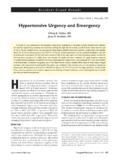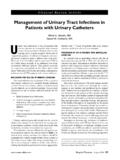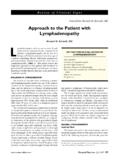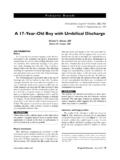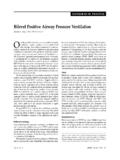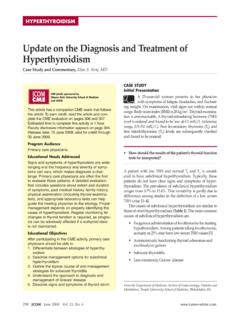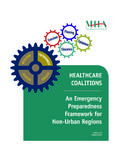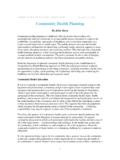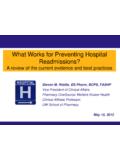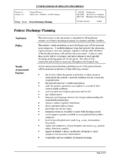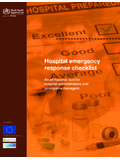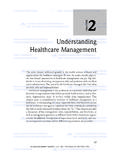Transcription of Pain Management: Classifying, Understanding, and …
1 Ccording to the International Association forthe Study of pain , pain is an unpleasant sen-sory and emotional experience associatedwith actual and potential tissue damage, ordescribed in terms of such damage, or both. 1 Thisdefinition emphasizes the subjective and psychologicalnature of pain and appropriately avoids making theauthenticity of pain contingent on an externally verifi-able stimulus. Price2 similarly proposes that painshould be understood as a somatic perception involv-ing a bodily sensation with qualities similar to thosereported during tissue - damaging stimulation, anexperienced threat associated with this sensation, anda feeling of unpleasantness or other negative emo-tions based on the experienced its 2001 implementation of pain - related standardsof care, the Joint Commission on Accreditation ofHealthcare Organizations (JCAHO)
2 Linked pain to physi-cal and emotional In justifying pain -relatedaccreditation standards, JCAHO pointed out the connec-tion between unrelieved pain and negative physiologicand psychological effects, generalizing these adverse out-comes from the hospitalized patient to the majority ofpatients in nearly all health care settings (eg, hospitals,long - term care facilities, surgical centers, mental healthfacilities, home health services, health system networks).This article, the first of an occasional series of arti-cles about pain management , discusses the classifica-tion of pain as the initial strategy for treating comments on the psychological aspects of pain ,the general pharmacologic management of pain , andspecial considerations in elderly patients are treatment of topics such as complex pharma-cotherapy, pain syndromes, assessment methods, andnonpharmacologic approaches to pain managementwill be provided in future PAINPain is generally classified according to its location,duration, frequency, underlying cause, and of pain is thus complicated and can be asource of confusion for many clinicians.
3 As a result,many practitioners now commonly use several differ-ent classification systems. Clear distinctions betweenthese systems are not always possible: the more simplis-tic the classification of pain , the greater the number ofomissions and overlaps that can To successfullymanage pain , practitioners must be able to work withpain classifications that encompass all considerations(ie, time course, involved anatomy, intensity, type ofpatient, and specific pathology) and be able to switchfrom model to model, depending on a patient s indi-vidual of PainPain is often classified by body location. Two over-lapping schemes relate the pain to the specific anato-my and/or body system thought to be involved.
4 Theanatomic pain classification system identifies sites ofpain as viewed from a regional perspective (eg, lowerback pain , headache, pelvic pain ). In contrast, thebody system pain classification method focuses on clas-sical body systems (eg, musculoskeletal, neurologic, vas-cular). Yet, both classification systems address only asingle dimension (ie, where or why does the patienthurt) and thus may ultimately fail to adequately definethe underlying neurophysiology of the of PainThe duration of the pain process is the most obvi-ous distinction that can be made when classifying painsymptoms. Conventionally, acute pain is limited to painof less than 30 days duration, whereas chronic painpersists for more than 6 months.
5 Subacute pain com-prises the interval from the end of the first month tothe beginning of the seventh month of continuedpain. Recurrent acute pain describes a pain patternthat persists over an extended period of time butoccurs mainly as isolated episodes of pain . ChronicADr. Cole is the Program Dean, pain Studies, University of IntegratedStudies; and the Director, Continuing Medical Education, AmericanAcademy of pain management , Sonora, - Physician June 200223 Clinical Review ArticlePain management : classifying , understanding , and Treating PainB. Eliot Cole, MD, MPApain is further divided by its underlying etiology intonon cancer - related pain (often called benignor non-malignant pain ) and cancer - related pain (often calledmalignant pain ).
6 6 8 The primary distinction between acute and chronicpain, regardless of its etiology, is crucial. Acute pain isuseful and serves a protective purpose. It warns of dan-ger, limits use of injured or diseased body parts, andsignals the departure of pathology when the limitingcondition resolves. Without acute pain , it is doubtfulthat human survival would be possible at Chronicpain, on the other hand, has little protective signifi-cance, persists despite normalization after injury or dis-ease, and ultimately interferes with productive after surgery (ie, postoperative pain ) is a specif-ic type of acute pain . No matter how successful or wellperformed, operations cause tissue trauma and releasepotent mediators of inflammation and pain .
7 This typeof pain is often poorly managed. Patients often receivesignificantly fewer opioid analgesic agents than areordered, either because the nursing staff may be overlyconcerned about opioid addiction or because analgesicagents are irrationally selected by physicians, many ofwhom have inadequate knowledge about the pharma-cology of such Although postoperative pain isexperienced by millions of patients throughout theworld, it is rarely recognized as producing harmfulphysiologic or psychological axiom No one ever died from pain is clearlyincorrect, given the modern recognition that unrelievedpain increases cardiac work, increases metabolic rate,interferes with blood clotting, leads to water retention,lowers oxygen levels.
8 Impairs wound healing, altersimmune function, interferes with sleep, and creates neg-ative 17 Unrelieved pain can, for example,delay the return of normal gastric and bowel function inpostoperative Recognition of the widespreadinadequacy of acute pain management prompted theUnited States Department of Health and HumanServices to publish Acute pain Managementas the first setof federal clinical practice pain confuses most sufferers, because itdominates, depresses, debilitates, and ultimately lowersquality of life. If chronic pain is treated only by usingacute pain models, it may become more intense, andpatients may experience increased disability and suffer-ing. Instead of comfort measures alone, chronic painshould be managed by the use of rehabilitative tech-niques when the pain is primarily of a noncancerousorigin or by aggressive and supportive techniqueswhen the pain is primarily caused by cancer.
9 Chronicpain patients, unfortunately, demand more effort andresources than a single, well- meaning practitioner canusually provide. In isolation, the solo practitioner isgenerally unable to address the complex physical, psy-chosocial, and spiritual problems that chronic paincauses and so resorts to symptom management , usuallyby overuse of a single therapeutic pain must be recognized before the painbecomes chronic. In this regard, the presence of suba-cute pain , which is quite similar to acute pain in its etio-logic and nociceptive mechanisms,6 may offer physiciansthe last opportunity for a full restoration of patients to apain - free existence. Once the pain has been establishedfor more than 6 months, the likelihood of completepain relief is small (Richard Kroening, MD, PhD, oralcommunication).
10 Kroening elaborates that most pa-tients, during the first 100 days of pain , appear to re-spond fully to therapy and often can return to near nor-mality. Beyond this time, however, patients generally donot feel fully restored or comfortable, even when theyrecover the majority of lost function. By the time painbecomes subacute, the rehabilitative approach used forchronic pain is usually more appropriate than are fur-ther acute pain management acute pain involves the acute flare - up ofperipheral tissue pathology resulting from an underly-ing chronic pathologic entity. Typically, headaches, gas-trointestinal motility disorders, degenerative disk andjoint disease, collagen vascular disease, sickle cell dis-ease, and similar functional processes can elicit thistype of Unlike chronic or subacute pain , recur-rent acute pain implies discrete acute episodes, whichreturn over time.
